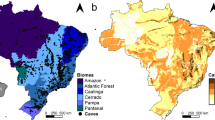Abstract
In order to establish a monitoring method to track long term changes of the amount of anthropogenic contamination in a district of Bavaria (Germany), a biomonitoring campaign with honey bees was performed in spring 2002. Expected anomalies from the industry or from residential areas in the sampled district could not be detected. An anomaly over a considerable part of the sampling area correlating with other phenomena lead to the hypothesis of a prehistoric cosmic impact. Moreover a principal component analysis of the data showed evidence for a biogenic, an anthropogenic and an unknown component hypothetically related to a possible cosmic impact.
Similar content being viewed by others
References
Barbarosa Fuentes, M.: 1998, European Community ECO-management and Audit Scheme, Publications by the Institute for European Law at Stockholm University, Jure AB, Stockholm, Sweden
Bayerisches Staatsministerium für Landesentwicklung und Umweltfragen: 2000, ‘Bayern-Agenda 21 für eine nachhaltige und zukunftsfähige Entwicklung in Bayern’, ISBN 3-910088-49-X.
Blevins, D. G. and Lukaszewski, K. M.: 1994, ‘Proposed physiologic functions of boron in plants pertinent to animal and human metabolism’, Environ. Health Perspect. 102(Suppl. 7), 31–33.
Bromenshenk, J. J., Smith, G. C. and Watson, V. J.: 1995, ‘Assessing ecological risks in terrestrial systems with honey bees’, in: F. M. Butterworth (ed.), Biomonitors and Biomarkers as Indicators of Environmental Change, Plenum Press, New York, pp. 9–30.
Bromenshenk, J. J., Cronn, R. C. and Nugent, J. J.: 1996, ‘Monitoring fluoride with honey bees in the upper snake river plain of idaho’, J. Environ. Qual. 25, 868–877.
Fehr, K. T., Hochleitner, R., Hölzl, S. and Geiss, E.: 2004, ‘Ferrosilizium-Pseudometeorite aus dem Raum Burghausen, Bayern’, Aufschluss 55, 297–303.
Harper, H. A., Rodwell, V. W. and Mayes, P. A.: 1979, Review of Physiological Chemistry, Lange Medical Publications, Los Altos, California, USA.
Höffel, I. and Müller: 1983, ‘Schwermetallrückstände in Honigbienen (Apis mellifica L.) in einem ökosystem (Saarbrücken)’, Forum Städte-Hygiene 34, 191–193.
Hoffmann, V. and Rösler, W.: 2005, ‘Anomalous magnetic signature of soils/sediments in SE Bavaria’, Special Volume of Physics of the Earth and Planetary Interiors, EGU 2004.
Hoffmann, V., Rösler, W. and Raeymaekers, B.: 2004, ‘Evidence for an impact strewn field in SE Bavaria’, Presentation held at Paneth Kolloquium, Nördlingen (Germany), 13–14 Oct. 2004.
Nürnberg Airport, Press Office, 2003: ‘Airport Nuremberg engages 30.000 new workers to monitor the environment’, Press Release No. 17/03 (23 October 2003).
Raeymaekers, B., 2004: ‘Beewatch — Biomonitoring mit Honigbienen. Bericht über eine Monitoringkampagne im Landkreis Altötting — Frühling 2002’, Report for the District Council of Altötting, Germany.
Raeymaekers, B. and Schrijvers, D.: 2004, ‘Iron silicides and other metallic species in the SE Bavarian strewn field’, Presentation held at Paneth Kolloquium, Nördlingen (Germany), 13–14 Oct. 2004.
Root, A. I.: 1948, ABC and XYZ of Bee Culture, The A.I. Root Cie, Medina, Ohio, USA.
Sager, M.: 2000, ‘Spurenelemente in Honig’, in: Arbeitsgemeinschaft landwirtschaftlicher Versuchs-anstalten — Jahrestagung 2000 in Gmünden, 2000, Gmünden, Austria, pp. 113–114.
Statistical Graphics Corporation: 1998, Statgraphics Plus, Standard Edition, Manugistics Inc., USA.
Tong, S. S. C., Morse, R. A., Bache, C. A. and Lisk, D. J.: 1975, ‘Elemental analysis of honey as an indicator of pollution’, Arch. Environ. Health 30, 329–332.
Umweltbundesamt Berlin: 1998, ‘Pflanzenbelastung auf kontaminierten Standorten — Ergebnisse des internationalen Workshops “Plant Impact at Contaminated Sites”’, Umwelt 4, 168–169.
Wallwork-Barber, K. M., Ferenbaugh, R. W. and Gladney, E. S.: 1982, ‘The use of honey bees as monitors of environmental pollution’, Am. Bee J., November, 770–772.
Author information
Authors and Affiliations
Corresponding author
Rights and permissions
About this article
Cite this article
Raeymaekers, B. A Prospective Biomonitoring Campaign with Honey Bees in a District of Upper-Bavaria (Germany). Environ Monit Assess 116, 233–243 (2006). https://doi.org/10.1007/s10661-006-7389-8
Received:
Accepted:
Issue Date:
DOI: https://doi.org/10.1007/s10661-006-7389-8




